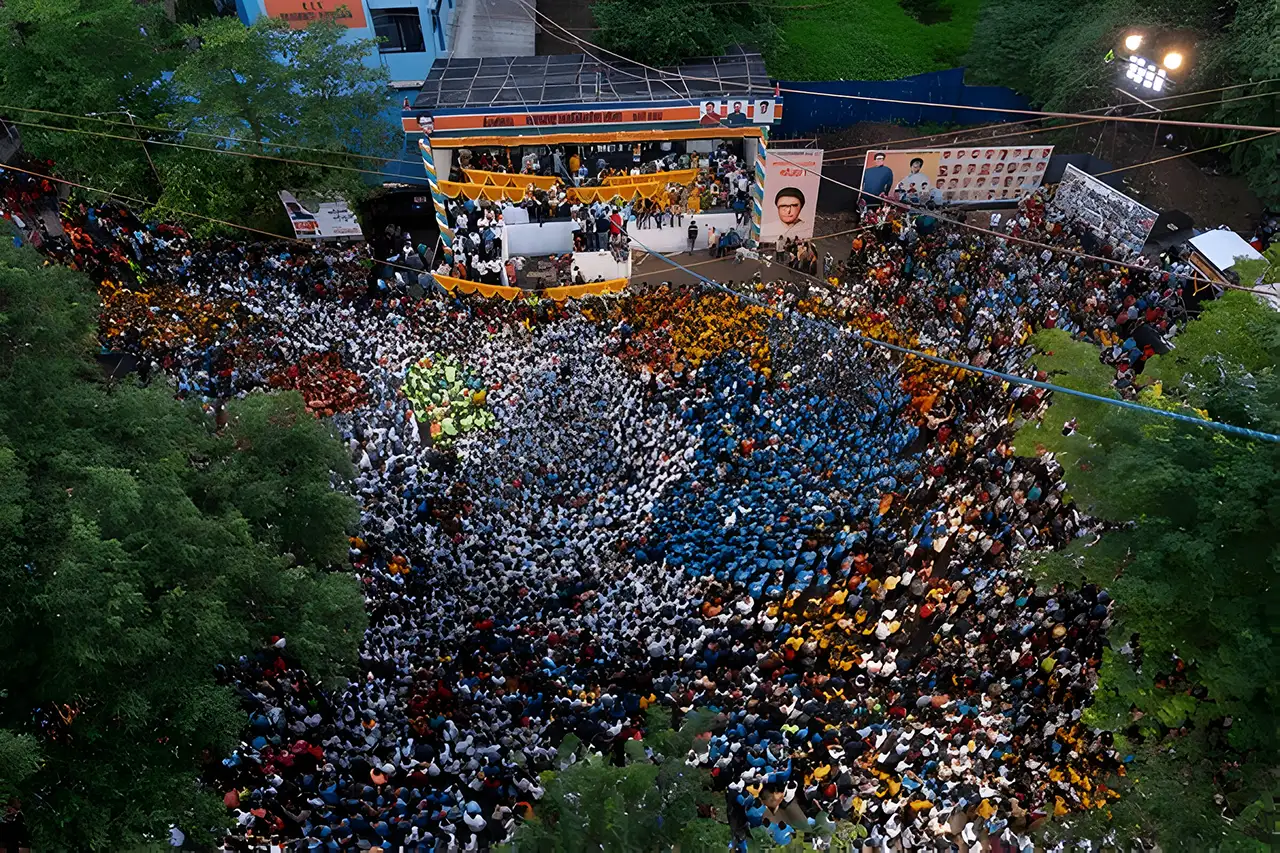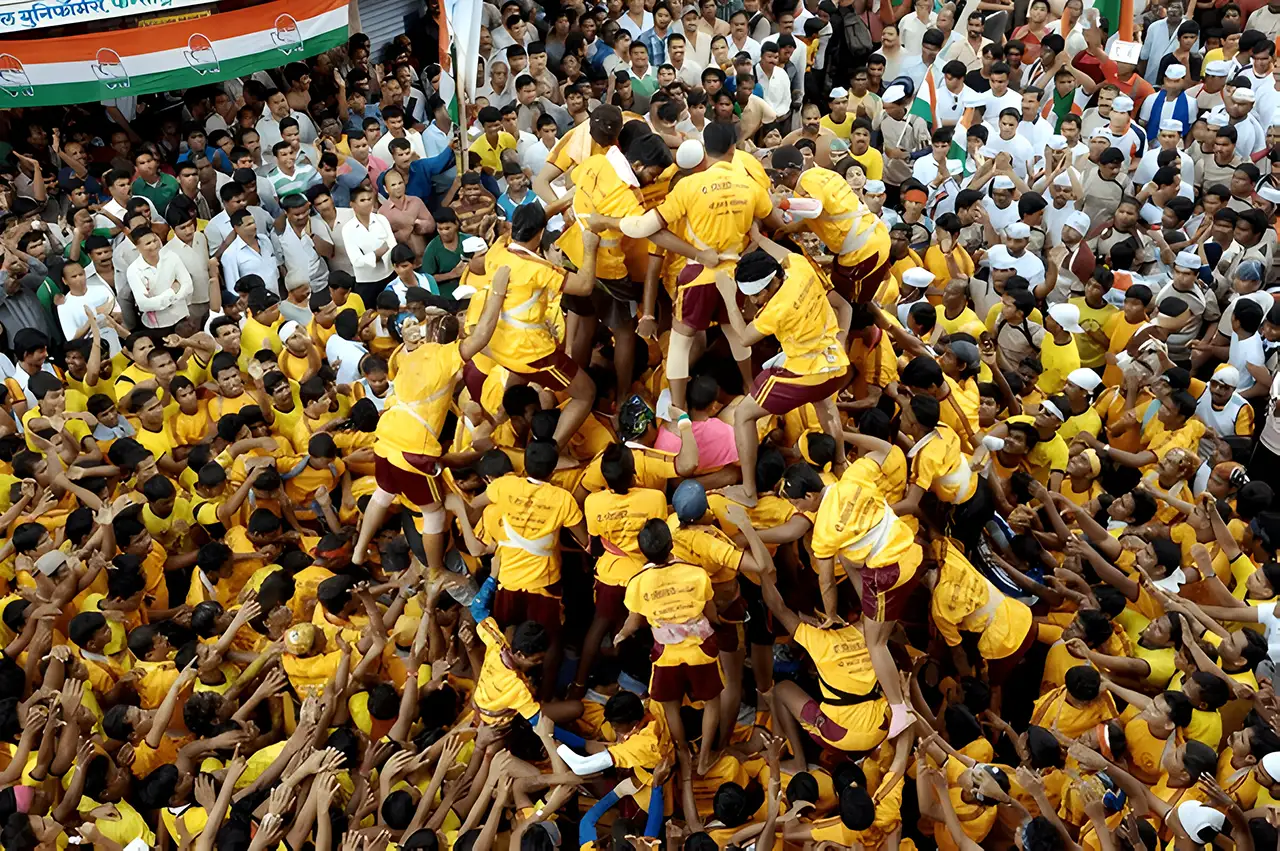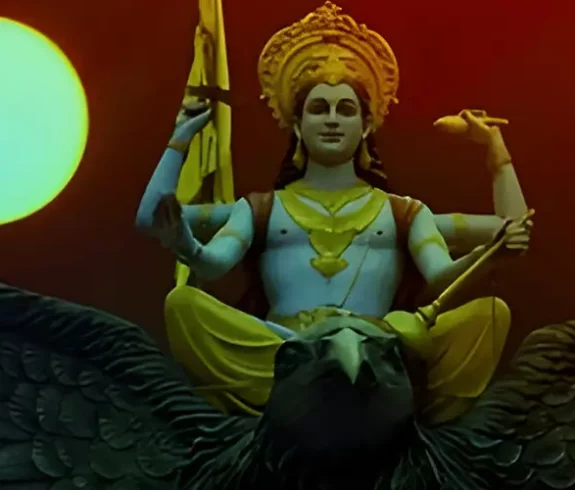Hindus celebrate Lord Krishna Janmashtami, a festival commemorating the birth of Lord Krishna, the eighth avatar of Vishnu. According to Hindu traditions, Lord Krishna was born in Mathura during the Dwapar Yuga to eliminate the evil forces plaguing the world. This vibrant festival is one of the most significant religious events in Hinduism, observed with immense devotion.
Also known as Krishna Gokulashtami or Sri Krishna Ashtami, the festival takes place on the eighth day of Krishna Paksha during the month of Bhadrapada. Devotees worldwide mark this auspicious day through fasting, prayers, and various rituals to honor Lord Krishna’s divine birth.

Significance of Lord Krishna Janmashtami in the Hindu Religious Calendar
- Victory of Good Over Evil: The celebration of Lord Krishna Janmashtami represents the triumph of good over evil. The birth of Lord Krishna ended the reign of terror imposed by Kansa, symbolizing the eradication of darkness with the light of righteousness.
- Emphasis on Divine Teachings: On Sri Krishna Jayanthi, devotees reflect on Lord Krishna’s teachings, especially those in the Bhagavad Gita. His lessons on dharma (righteousness), karma (action), and bhakti (devotion) are central to Hindu beliefs.
- Fasting as Devotion: Observing a fast during Krishna Gokulashtami is an essential act of purification for devotees. The fast continues until midnight, the time of Lord Krishna’s birth, strengthening the spiritual connection between devotees and the deity.
- Joyful Cultural Celebrations: Festivities such as Dahi Handi and devotional singing are vital features of the celebration. These cultural practices during Krishna Jayanthi unite communities, fostering unity in devotion to Lord Krishna.
- Symbolism of Faith: Sri Krishna Ashtami powerfully reminds us of the significance of faith. The rituals and traditions highlight the importance of trusting in the divine, offering guidance through life’s challenges.
- Enduring Legacy of Devotion: Lord Krishna Jayanthi continues to shape Hindu religious practices, with devotees honoring Lord Krishna’s life and values. The festival remains a cornerstone of the Hindu religious calendar, embodying Lord Krishna’s timeless teachings.
Historical and Mythological Background of Lord Krishna Janmashtami
The birth of Lord Krishna, as reported in religious books such as the Mahabharata or the Bhagavatam Purana, has been called the most significant event. Thus, Janmashtami has become a grand festival with both cultural and mythological ramifications. These texts reveal Krishna’s divine purpose and miraculous entrance into this world.
The Divine Birth of Krishna
The Bhagavata Purana vividly narrates Lord Krishna’s birth during a time of chaos when evil plagued the Earth. In response, Lord Vishnu chose to incarnate as Krishna during the Dwapar Yuga to purge the world of darkness.
The Prophetic Message
Born to Devaki and Vasudeva under the oppressive rule of the tyrant Kansa in Mathura, Krishna’s birth was shadowed by a prophecy. This prophecy declared that Devaki’s eighth son would topple Kansa’s reign. To thwart his fate, Kansa imprisoned his sister Devaki and her husband, executing their first seven children.
Miraculous Events and Krishna’s Escape
Krishna’s birth unfolded under miraculous conditions. Although confined to a dungeon, mystical forces put the guards to sleep, loosened their chains, and quietly opened the gates. Vasudeva carried the newborn across the parted waters of the Yamuna River to safety in Gokul, where Nanda and Yashoda would raise him.
Krishna’s Divine Role and Teachings
Krishna Gokulashtami celebrates both Krishna’s birth and his divine purpose as a dispenser of justice and a teacher of the Dharma. His profound teachings, which he later articulated in the Bhagavad Gita during the Mahabharata war, shed light on duty, righteousness, and devotion, underscoring his crucial role in re-establishing moral order and guiding humanity toward spiritual awakening.

Significance of Lord Krishna Janmashtami
Lord Krishna Janmashtami profoundly resonates within Hinduism, highlighting key themes such as righteousness, devotion, and divine love. This festival honors the birth of Lord Krishna, an incarnation of Vishnu, and showcases the triumph of good over evil. Below, we explore how this festival is pivotal for spiritual reflection and celebration within the Hindu community.
Spiritual Importance of Krishna in Hinduism
- Manifestation of Vishnu: Lord Krishna, as a central figure of Vishnu, plays a crucial role in maintaining the universe’s balance. His life and teachings offer moral and spiritual guidance to his devotees.
- Teacher of Dharma: Celebrated on Lord Krishna Janmashtami, Krishna’s teachings in the Bhagavad Gita provide profound insights into duty, justice, and spiritual enlightenment, continually guiding his followers.
Themes Celebrated During Janmashtami
Triumph of Good Over Evil:
Symbolic Victory: The festival commemorates Krishna’s victory over the despot Kansa, embodying the triumph of righteousness. This story inspires believers to uphold their faith and integrity, even under challenging circumstances.
Devotion (Bhakti):
Devotional Practices: Devotees express their reverence and affection for Krishna through fasting, chanting hymns, and engaging in sacred dances and plays, deepening personal and communal spiritual connections.
Divine Love:
Universal Love: The narratives of Krishna’s life emphasize his role in promoting unconditional love. Janmashtami is a particular time to celebrate these teachings, which advocate for compassion and empathy within communities.
Practical Implications of Janmashtami
- Moral Reflection: This festival allows devotees to reflect on their morals and values, urging them to align their actions with Krishna’s teachings for a righteous life.
- Community Bonding: Krishna Jayanthi enhances community bonds through shared worship and festivities, fostering a collective sense of belonging and spiritual growth.
- Cultural Preservation: The observance of Krishna Gokulashtami plays a critical role in transmitting cultural and spiritual heritage to the next generation, ensuring the preservation of these rich traditions.
Ceremonies and Rituals of Lord Krishna Janmashtami
Lord Krishna Janmashtami brims with colorful ceremonies and deep-rooted rituals that capture the essence of devotion and celebration. This overview details the significant rituals that define this sacred day, focusing on devotees’ practices to honor Lord Krishna’s birth.
Midnight Celebrations: Welcoming the Birth of Krishna
- Fasting Until Midnight: Devotees begin their fast at sunrise and continue until midnight, the believed time of Lord Krishna’s birth. The fast symbolizes a deep cleansing of body and spirit, demonstrating the devotees’ faith and eager anticipation of the divine birth.
- Breaking the Fast: When the clock strikes midnight, devotees perform rituals at home or in temples, which involve bathing the Krishna idol and dressing it in new garments. The fast concludes with the sharing of ‘Prasadam,’ sacred food that often includes fruits, sweets, and other blessed items.
Dahi Handi: Celebrating Krishna’s Playful Aspect
- Human Pyramids: In Maharashtra, the Dahi Handi ritual celebrates Krishna’s naughty childhood. ‘Govindas’ teams construct towering human pyramids to reach and break a pot with yogurt suspended high above the ground.
- Symbolism and Excitement: This vibrant event highlights Krishna’s playful nature and promotes unity and joy among community members. Accompanied by festive music and dance, it transcends the spiritual to become a grand cultural celebration.
Recitations and Bhajans: Devotional Harmony
- Chanting and Singing: On Krishna Jayanthi, hymns, bhajans, and scripture recitations, especially from the Bhagavad Gita, fill the ambiance with musical sounds. These spiritual songs elevate the festivity’s atmosphere, drawing participants closer to the divine.
- Scripture Readings: During this festival, devotees regularly read passages from the Bhagavad Gita, reflecting on Krishna’s teachings. This practice reveres him as a spiritual mentor and allows devotees to contemplate their spiritual paths.
- Community Gatherings: Temples and community centers become focal points for these celebrations, hosting ongoing recitational events that unite individuals and families in a collective reverence.

Regional Variations of Lord Krishna Janmashtami Celebrations
All over the world, Lord Krishna Janmashtami resonates, and people in India or anywhere else where communities of Indians live celebrate it with great devotion and zest. This festival has a range of unique local customs that add to its colorfulness. Let’s look at what these different areas and groups do to pay homage to this important day.
Northern India: The Magic of Rasa Lila
- Highlighting Rasa Lila Performances: The Rasa Lila dance captivates many in Northern India, especially Mathura and Vrindavan, Krishna’s birthplace and childhood realm. This dance portrays Krishna’s early life and interactions with the Gopis, showcasing spiritual performances that epitomize divine love and devotion.
- Exuberant Decorations and Gatherings: Devotees extensively adorn temples and homes with flowers and lights, and large gatherings are typical, with people assembling at temples for special prayers and ceremonies.
Western India: The Joy of Dahi Handi
- Celebrating with Dahi Handi: The Dahi Handi event is a significant highlight in Maharashtra. Community teams, known as ‘Govindas,’ build human pyramids to reach and shatter pots of yogurt suspended high above, echoing Krishna’s youthful mischief.
- Creating a Festive Atmosphere: This event incorporates lively music and dancing, with broad community involvement, transforming it into a significant social and cultural festivity.
Southern India: Melodies, Fasts, and Sacred Offerings
- Devotional Songs and Prayers: In Southern states like Tamil Nadu and Karnataka, devotees perform devotional songs, engage in prayer, and make exceptional ‘Prasadam’ offerings to Krishna.
- Intricate Decorative Practices: Many homes display detailed footprints from the entrance to the prayer area, symbolizing Krishna’s entrance into their homes and hearts.
Eastern India: Commitment through Fasting and Vigils
- Observing Fasts and Vigils: In West Bengal and Odisha, devotees undertake a strict fast and hold all-night vigils (‘Jagarana’), reciting hymns and stories of Krishna’s life until midnight, marking his sacred birth moment.
- Crafting Unique Offerings: They prepare special dishes that blend local culinary traditions, dedicating these offerings to Krishna.
Global Celebrations: Embracing Diversity
- Integrating Local Cultures: Worldwide, Indian communities blend local customs with traditional rituals, including temple services, cultural programs, and food festivals that showcase Indian culinary diversity.
- Enhancing Community Engagement: These international celebrations often draw not only the Indian diaspora but also people from various cultural backgrounds, promoting a broader appreciation of Hindu practices.
Cultural and Social Aspects of Lord Krishna Janmashtami
Krishna Janmashtami is not just a usual religious event but an impressive cultural festival that brings people together in neighborhoods and among relatives. Krishna Gokulashtami, or Sri Krishna Ashtami, is an important festival that creates social bonds and promotes community unity. This article examines how Janmashtami encourages community spirit and family unity through shared rituals and festive events.
Encouraging Community Spirit
- Engaging in Collective Rituals: During Lord Krishna Janmashtami, entire communities come together in temples, praying, singing bhajans, and participating in devotional activities. These collective rituals foster a shared sense of devotion and unity, celebrating Krishna’s birth together.
- Hosting Cultural Events and Performances: Cultural events, such as dramatic portrayals of Krishna’s life, Rasa Lila dances, and Dahi Handi competitions, accompany the religious observance. These artistic expressions unite the community, creating a welcoming atmosphere that bridges diverse social backgrounds.
- Promoting Social Harmony: Janmashtami’s inclusive nature helps dissolve social barriers, inviting people from all walks of life to join the festivities. This communal participation encourages a harmonious social environment where everyone shares in the celebration.
Strengthening Family Bonds
- Celebrating within Families: Krishna Jayanthi is a time for families to gather, decorate their homes, cook unique dishes, and engage in traditional rituals together. These activities offer precious moments for bonding, sharing responsibilities, and building lasting memories.
- Imparting Cultural and Religious Values: Celebrating Sri Krishna Jayanthi allows parents and elders to pass down important cultural and religious values to the younger generations. Getting children involved in the preparations and rituals plants deep roots of cultural identity and continuity.
- Sharing Festivities: Preparing and sharing festive meals, collaborative home decorations, and temple visits deepen family ties. These shared experiences amplify the collective joy and unity of the celebration.
Fostering Community Feasts and Acts of Charity
- Organizing Community Feasts: In many regions, communities mark Janmashtami with feasts where people gather to share food and fellowship. These gatherings underscore the spirit of generosity and community support.
- Engaging in Charitable Activities: Janmashtami also inspires acts of charity, such as distributing food to the needy and donating to charitable causes; these acts of giving highlight the festival’s commitment to compassion and communal support.

Modern Celebrations of Lord Krishna Janmashtami
The festival of Lord Krishna Janmashtami, which is dear to many hearts, is also surviving in times of modernity and change. Celebrations for Krishna Gokulashtami have adapted to suit the requirements of modern lifestyles while remaining traditional. Thus, this summary reveals how technology and urban areas influence celebrations today.
Embracing Technology: Virtual and Online Celebrations
- Streaming Temple Ceremonies Online: The advent of technology allows numerous devotees to partake in Lord Krishna Janmashtami through digital platforms. Temples globally now livestream their ceremonies, making them accessible from home and broadening the festival’s reach.
- Engaging in Virtual Celebrations: Beyond live streams, virtual gatherings have gained popularity. Via video conferencing, families and communities unite to perform prayers, chant bhajans, and observe Krishna Jayanthi, bridging distances and preserving the festival’s communal essence.
- Accessing Digital Devotional Content: Advances in technology facilitate access to devotional materials, such as e-books, podcasts, and online talks about Krishna’s life and teachings. These resources enhance the spiritual experience of Sri Krishna Ashtami for devotees worldwide.
Urbanization and Its Impact on Celebrations
- Adjusting to Urban Lifestyles: Urbanization has altered daily routines, prompting the tailoring of Janmashtami celebrations to suit the busy lives of urban residents. Urban temples now schedule shorter and more flexible rituals to accommodate the schedules of professionals and students.
- Organizing Community Celebrations in Urban Settings: Despite urban challenges, the community spirit during Sri Krishna Jayanthi remains vibrant. Housing societies and city community groups host collective celebrations, including Dahi Handi competitions and cultural performances, fostering neighborly bonds.
- Adopting Eco-Friendly Practices: Urban celebrants increasingly embrace eco-friendly measures during Janmashtami. These include using sustainable decor, plant-based dyes, and reducing waste, reflecting a commitment to environmental sustainability amidst traditional festivities.
Social Media and Digital Outreach
- Spreading Festive Cheer via Social Media: Social media platforms significantly enhance the visibility of Lord Krishna Janmashtami celebrations. Devotees post photos and videos of their celebrations and altars, using hashtags like #Happy Krishna Janmashtami to share the joy with a broader audience.
- Building Online Communities: Devotees frequently join online forums and social groups focusing on Sri Krishna Ashtami rituals and celebrations. These platforms serve as spaces for exchanging recipes, discussing rituals, and sharing celebration tips, fostering a global community of Krishna followers.
Personal Stories and Community Voices: The Impact of Lord Krishna Janmashtami
Lord Krishna Janmashtami resonates deeply with millions, serving as a religious event and a profoundly personal and community-centric experience. Celebrated as Krishna Gokulashtami and Sri Krishna Ashtami, this festival intricately binds communities’ spiritual and cultural threads and profoundly touches individual lives. Here, we explore personal anecdotes and community insights that reveal how the festivities influence spiritual practices and foster closer community ties.
Personal Reflections: Deepening Spiritual Connections
- Devotional Morning Practices: Sunita from Bangalore starts her Janmashtami at dawn with special prayers to Krishna, setting up a small altar with his favorite offerings. “Fasting until midnight reinforces my spiritual connection, reminding me of the virtues Krishna embodies. Breaking the fast brings a deep peace and fulfillment,” she explains.
- Family Traditions and Cultural Heritage: From Mumbai, Rajesh highlights how Janmashtami fosters family bonding. “Together with my children, we decorate our home and create little footprints leading to our prayer room, symbolizing Krishna’s entry. It’s a fun way to engage my children with our heritage,” he notes.
Voices from the Community: Celebrating Unity and Connection
- Fostering Unity with Community Events: Meera, a community leader in Delhi, sees Krishna Jayanthi as essential for community bonding. “We gather annually for the Dahi Handi, where everyone’s efforts to build human pyramids culminate in collective joy. It’s a vivid demonstration of our community’s unity,” she shares.
- Maintaining Cultural Ties through Technology: Anita, an NRI in the USA, discusses connecting with her roots through technology. “Remote celebrations and online temple streams allow me to join in the festivities and maintain traditions despite the distance,” she states.
Spiritual Growth and Community Service
- Reflective Spiritual Practices: An elderly devotee from Varanasi reminisced about his life-changing experience during the festival. “What used to be a day of mere celebration has become a time for spiritual reflection. I delve into the Bhagavad Gita, absorbing its teachings on righteousness and devotion,” he reflects.
- Charitable Initiatives and Community Support: In Chennai, Ravi describes how his community incorporates charity into their celebration. “We organize food drives for the needy during the festival, a practice that extends Krishna’s compassion and enhances our communal bonds,” he details.

Navigating the Challenges and Controversies of Lord Krishna Janmashtami Celebrations
The birthday of Lord Krishna, or Krishna Gokulashtami, and Sri Krishna Ashtami, finds its roots in the essence of tradition and community customs. However, it faces challenges and controversies similar to other important festive occasions. Issues here are: Safety during Dahi Handi events is one major issue, while there is always that question of how much to stick to traditions instead of modernizing.
Addressing Safety During Dahi Handi
Mitigating Injury Risks: The Dahi Handi celebration, a festival staple, sees participants forming human pyramids to break a yogurt-filled pot. This exhilarating tradition, however, carries risks of falls and severe injuries.
Implementing Robust Safety Protocols
- Enforcing Height Limits: Setting a maximum height for pyramids can drastically decrease the likelihood of dangerous falls.
- Mandatory Safety Gear: All participants should wear helmets and protective padding.
- Onsite Medical and Supervisory Staff: It’s crucial to have medical professionals and safety supervisors present to manage any incidents promptly and effectively.
Balancing Tradition with Modernity
Honoring Cultural Values: As societal norms evolve, so do the celebrations of Lord Krishna Janmashtami. Keeping the fundamental elements of tradition while welcoming new forms of expression poses a delicate challenge.
Integrating Modern Approaches
- Facilitating Virtual Engagement: Providing online streaming and virtual participation options helps broaden access without diluting traditional values.
- Promoting Sustainability: Modern celebrations increasingly use eco-friendly materials for decorations and disposable items to minimize environmental impacts.
Tackling Commercialization and Other Controversies
- Addressing Commercialization Issues: The commercial aspects of events like Dahi Handi have sparked debates regarding the overshadowing of spiritual significance by entertainment and profit motives.
- Fostering Community Conversations: Involving community leaders, participants, and the general public in discussing the festival’s commercialization can help align the celebrations more closely with their spiritual and cultural roots.
- Enforcing Regulatory Measures: Implementing rules prioritizing cultural integrity and community benefits over commercial profits is crucial for preserving the festival’s traditional essence.
Conclusion: The Timeless Significance of Lord Krishna Janmashtami
Krishna Gokulashtami, or Sri Krishna Ashtami, is a great festival that signifies the importance of culture and spiritual connotations in Hindu mythology. People worldwide also recognize this date as Krishna Janmashtami. Furthermore, it not only represents the birth of Lord Krishna, who happens to be an avatar of Vishnu, but also serves as a celebration of spiritual values held dearly by people globally.
Embracing Spiritual Values
- Reflecting on Krishna’s Teachings: Each year, the festival poignantly reminds us of Krishna’s wisdom, as documented in the Bhagavad Gita, which covers pivotal lessons on duty, righteousness, and devotion. These teachings guide devotees’ moral and ethical choices, significantly enriching their spiritual tours.
- Advocating Bhakti Yoga: The festival highlights the path of Bhakti Yoga, promoting a life dedicated to service, compassion, and unwavering devotion to God. This celebration aspect underscores the attainability of spiritual development through dedication and love, resonating with a broad spectrum of spiritual followers.
Celebrating Cultural Heritage
- Exploring a Wealth of Myths: The festival vividly brings to life the extensive myths surrounding Krishna, from his divine birth to his youthful escapades, romantic exploits, and profound philosophical insights. These narratives not only entertain but also convey profound spiritual and ethical teachings.
- Engaging in Cultural Practices and Rituals: From engaging in the joyful Dahi Handi to participating in the reflective midnight prayers and melodious bhajans, the associated practices of Krishna Jayanthi are steeped in cultural significance, bolstering community connections and reinforcing the cultural identity of Hindus globally.
Fostering Unity and Embracing Change
- Strengthening Community and Family Ties: Whether celebrated amidst the vibrant streets of Mathura or in the serene privacy of a home overseas, Lord Krishna Janmashtami nurtures community and familial bonds. The festival unites individuals, transcending geographical and cultural barriers, in a shared celebration of faith and heritage.
- Adapting to Contemporary Realities: As the festival embraces modern innovations through online celebrations and global participation, its relevance endures, showcasing Hindu festivities’ flexibility and lasting appeal.
